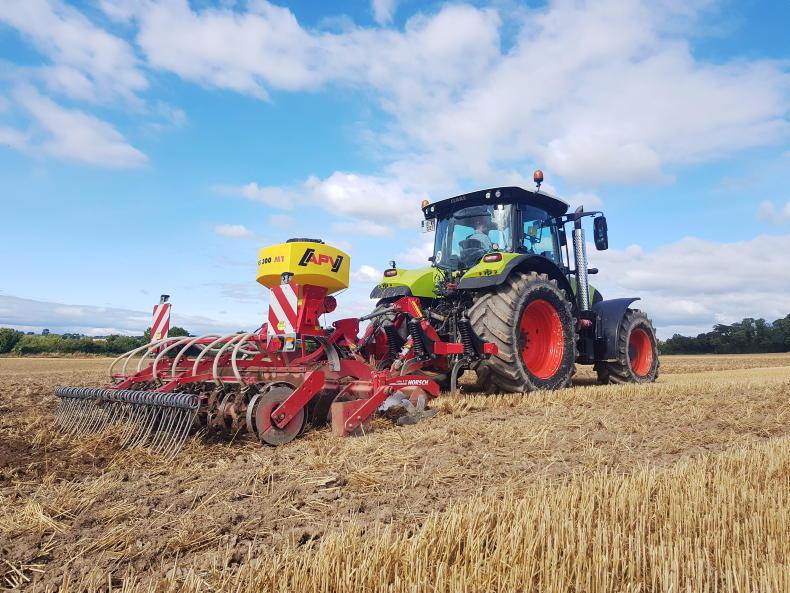Last year tillage farmers had to carry out stubble cultivation within 14 days of harvest for the first time and there was confusion around the rules as late changes were made to protect endangered bird species.
Research is to be carried out on how these rules impact on birds which are dependent on stubble and tillage crops.
Stubble cultivation requirements came in under nitrates regulations to create green cover on soil quickly after harvest. This green cover should take up some nitrates which are subject to loss to water if not taken up by a growing plant.
To leave habitats for birds a minimum of 20% and a maximum of 25% of the cereal land on a holding should not be cultivated.
On the land which does need to be cultivated the cultivation only needs to be shallow.
Cultivation should take place within 10 days of chopping or baling and must take place within 14 days of harvest.
Where grass weeds are a problem growers need to assess the types of grass they have. Some brome grasses need light to germinate and so should not be cultivated. In this case consolidation is allowed, so the field can be rolled to encourage the seeds to germinate. An adviser will have to state that the weeds are present. These weeds are meadow, rye and soft brome and blackgrass.
Straw incorporation measure
If you have applied for the Straw Incorporation Measure you will need to incorporate that straw into land as soon as possible after harvest.
ACRES
Farmers should remember that over-winter-stubble in ACRES means that stubbles should be cultivated to create a green cover.
Don’t change cropping decisions
The Irish Farmers Journal understands that while there is a requirement to leave stubbles uncultivated, this should not have an impact on the cropping decisions on the farm.
For example, if all of the farm is being planted to winter crops then no cultivations are required and no stubble needs to be left uncultivated. All land can be planted to winter crops.
This is the same in the case of a cover crop. For example, a farmer might want to grow a cover crop and graze it for fodder or might need to use their spring cropping area to plant cover crops under ACRES or cultivate stubbles under ACRES.
Cover crops
While cultivating there is an opportunity to plant cover crops. At present, costs on farm are high relative to price so it might be a difficult year to spend money on seed, but it should be considered and maybe a livestock farmer would graze these crops which would help to pay for the establishment costs.
Cultivation does not have to be carried out:
On an organic farm.Where root crops or late-harvested crops have been harvested. (late September onwards)Where a cereal or bean crop has been harvested after 15 September.Where a winter oilseed rape or cereal crop is due to be sown before 31 October.The 6m buffer beside a late-harvested crop does not need to be cultivated.
Last year tillage farmers had to carry out stubble cultivation within 14 days of harvest for the first time and there was confusion around the rules as late changes were made to protect endangered bird species.
Research is to be carried out on how these rules impact on birds which are dependent on stubble and tillage crops.
Stubble cultivation requirements came in under nitrates regulations to create green cover on soil quickly after harvest. This green cover should take up some nitrates which are subject to loss to water if not taken up by a growing plant.
To leave habitats for birds a minimum of 20% and a maximum of 25% of the cereal land on a holding should not be cultivated.
On the land which does need to be cultivated the cultivation only needs to be shallow.
Cultivation should take place within 10 days of chopping or baling and must take place within 14 days of harvest.
Where grass weeds are a problem growers need to assess the types of grass they have. Some brome grasses need light to germinate and so should not be cultivated. In this case consolidation is allowed, so the field can be rolled to encourage the seeds to germinate. An adviser will have to state that the weeds are present. These weeds are meadow, rye and soft brome and blackgrass.
Straw incorporation measure
If you have applied for the Straw Incorporation Measure you will need to incorporate that straw into land as soon as possible after harvest.
ACRES
Farmers should remember that over-winter-stubble in ACRES means that stubbles should be cultivated to create a green cover.
Don’t change cropping decisions
The Irish Farmers Journal understands that while there is a requirement to leave stubbles uncultivated, this should not have an impact on the cropping decisions on the farm.
For example, if all of the farm is being planted to winter crops then no cultivations are required and no stubble needs to be left uncultivated. All land can be planted to winter crops.
This is the same in the case of a cover crop. For example, a farmer might want to grow a cover crop and graze it for fodder or might need to use their spring cropping area to plant cover crops under ACRES or cultivate stubbles under ACRES.
Cover crops
While cultivating there is an opportunity to plant cover crops. At present, costs on farm are high relative to price so it might be a difficult year to spend money on seed, but it should be considered and maybe a livestock farmer would graze these crops which would help to pay for the establishment costs.
Cultivation does not have to be carried out:
On an organic farm.Where root crops or late-harvested crops have been harvested. (late September onwards)Where a cereal or bean crop has been harvested after 15 September.Where a winter oilseed rape or cereal crop is due to be sown before 31 October.The 6m buffer beside a late-harvested crop does not need to be cultivated. 









SHARING OPTIONS